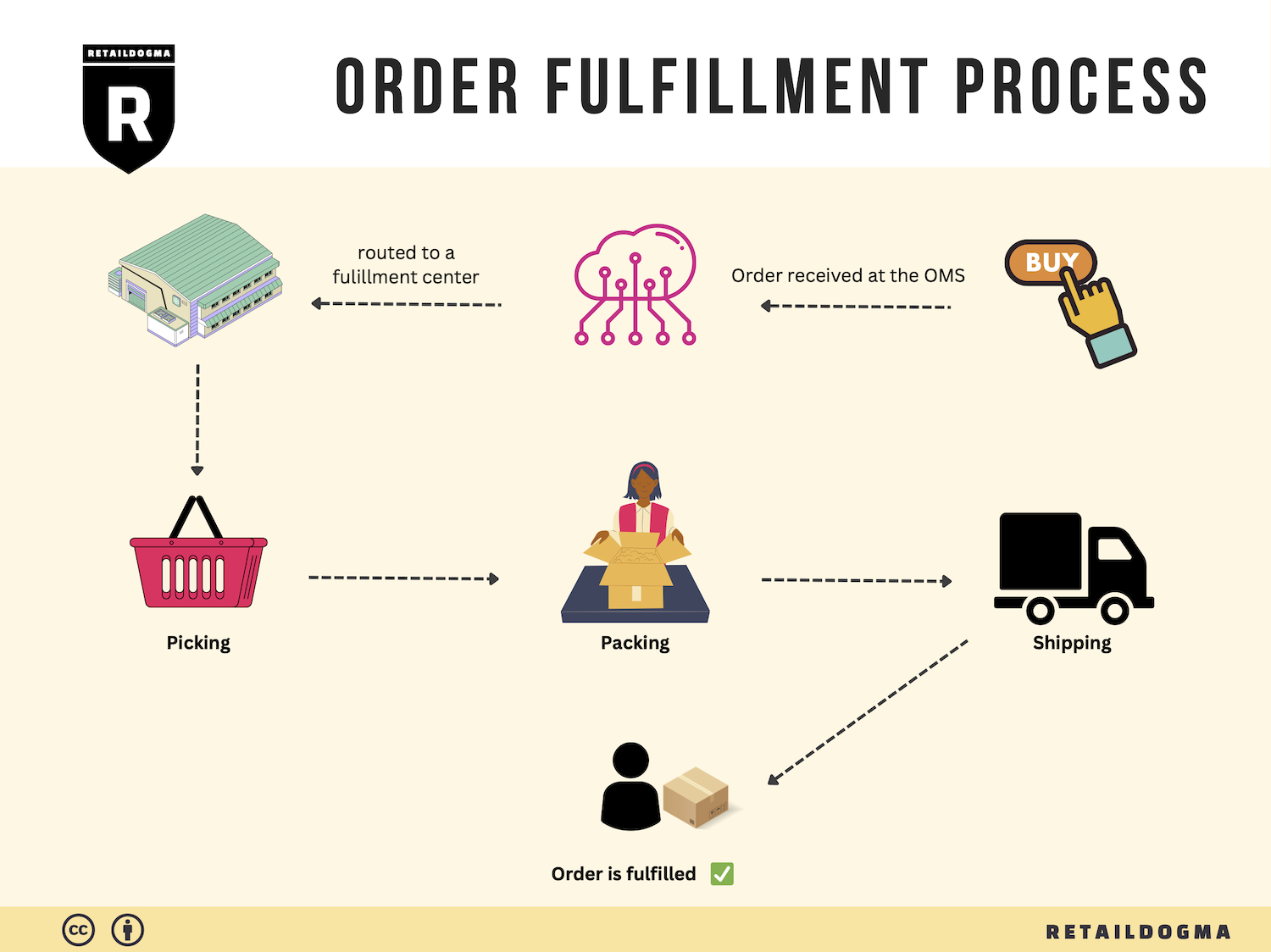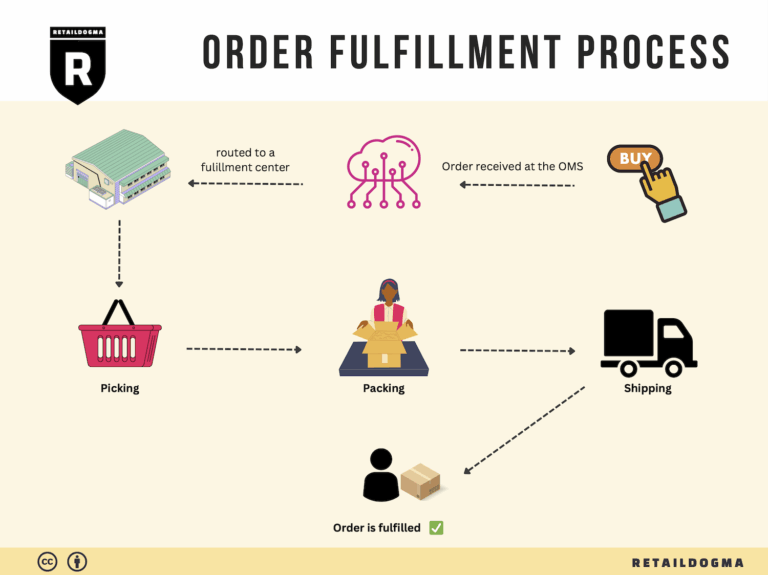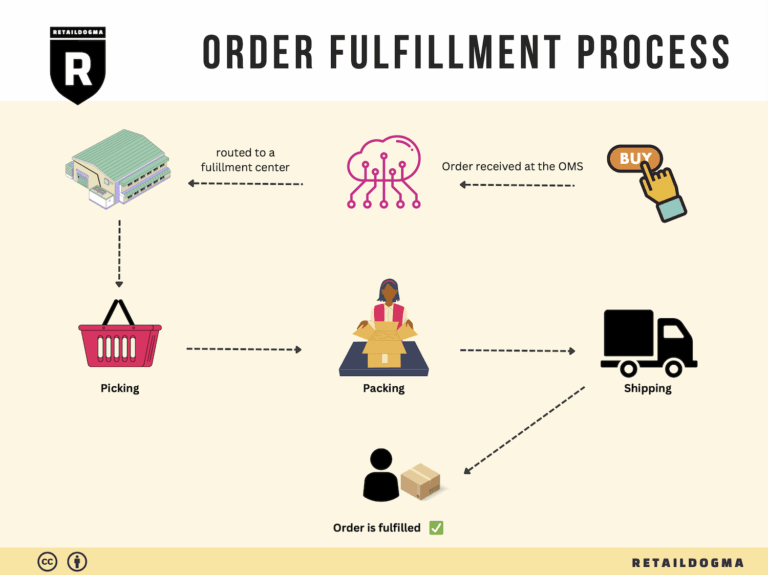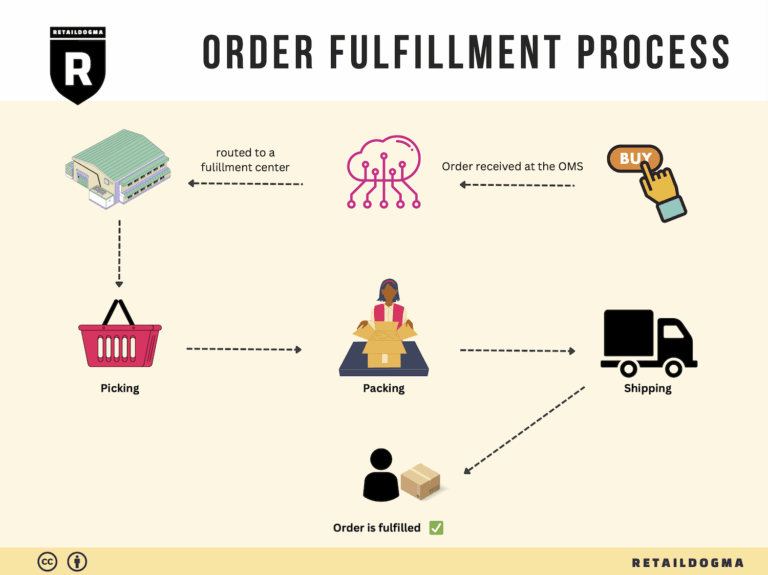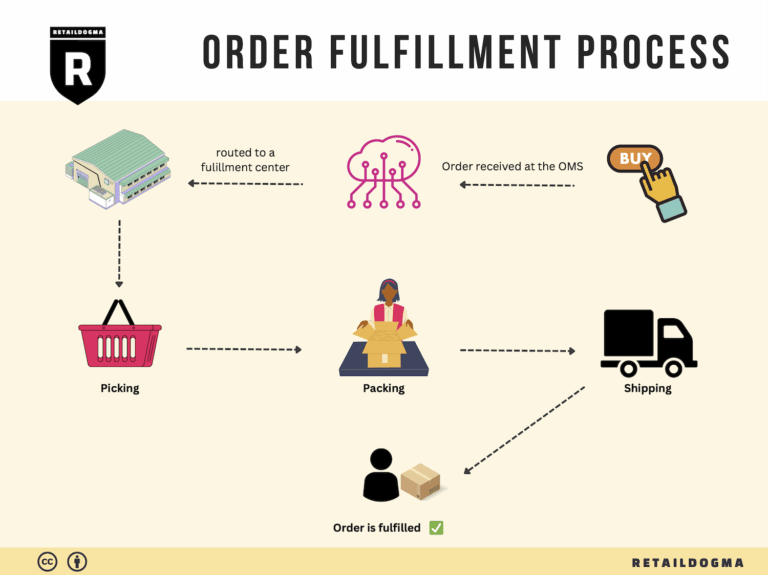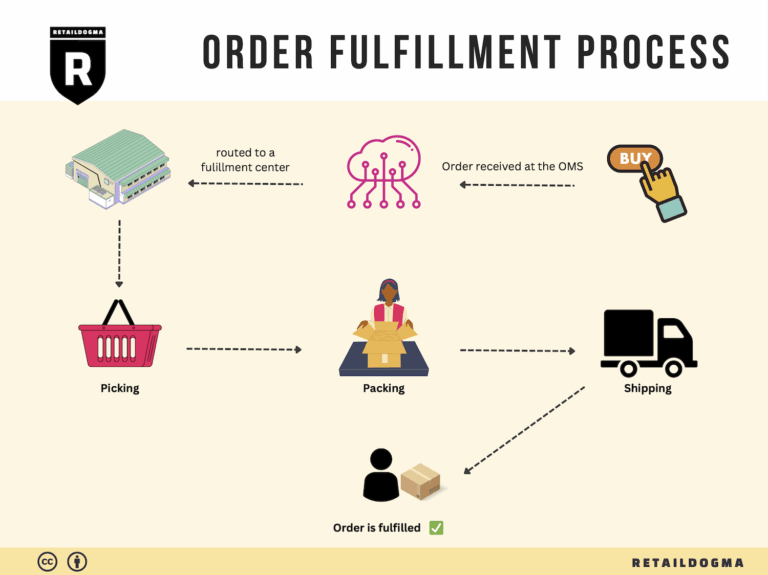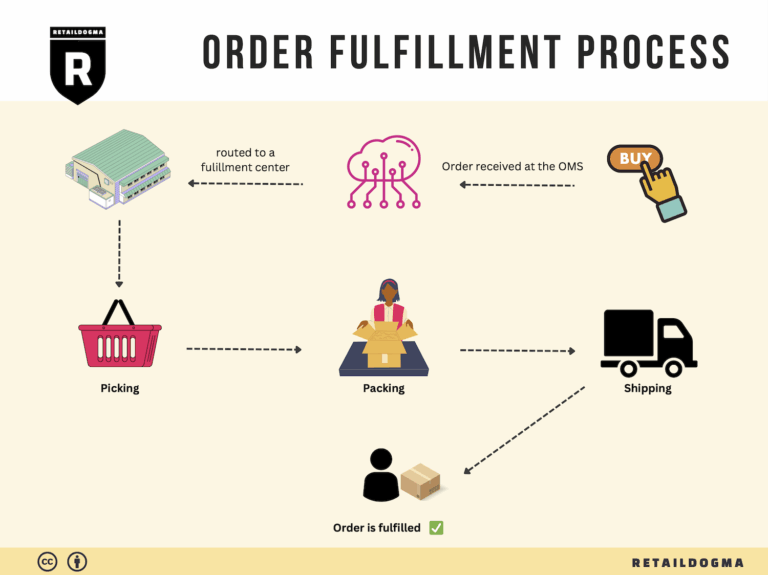What Is A Fulfillment Center? A Complete Guide (2025)
What is E-commerce Fulfillment? An Introduction for Growing Businesses
Understanding E-commerce Fulfillment: A Vital Process for Your Growing Business
As your e-commerce business scales, you might find yourself grappling with the increasing demands of packing and shipping orders. The excitement of making sales can quickly turn into frustration when the logistics of fulfilling those orders become overwhelming. This is a common pain point for many growing online businesses. Fulfillment, in its simplest form, is the process of getting a product from your inventory to the customer’s doorstep. However, it encompasses much more than just shipping.
Efficient e-commerce fulfillment is essential not only for customer satisfaction but also for maintaining your brand’s reputation and profitability. In today’s competitive landscape, customers expect prompt delivery and accurate order processing. Failing to meet these expectations can lead to dissatisfaction and lost sales, making it crucial to establish a streamlined fulfillment process.
This guide aims to demystify e-commerce fulfillment by exploring the various models available to businesses, such as third-party logistics (3PL) and Fulfillment by Amazon (FBA). We will delve into the core services associated with fulfillment, including inventory management, order processing, shipping, and returns handling. Understanding these services is vital for selecting the right fulfillment strategy that aligns with your business goals.
Choosing a fulfillment partner can be daunting, given the myriad options available. This guide will outline key considerations to help you evaluate potential partners, including their technology capabilities, service levels, and scalability. Additionally, we will discuss pricing structures and how to navigate the costs associated with different fulfillment models, ensuring you can make informed financial decisions.
Ultimately, the goal of this guide is to empower you to make smart decisions about your logistics operations. By understanding the intricacies of e-commerce fulfillment, you can better position your business for growth, improve customer satisfaction, and enhance your overall operational efficiency. Whether you’re a seasoned entrepreneur or just starting, this guide will provide the insights needed to take control of your fulfillment process and drive your business forward.
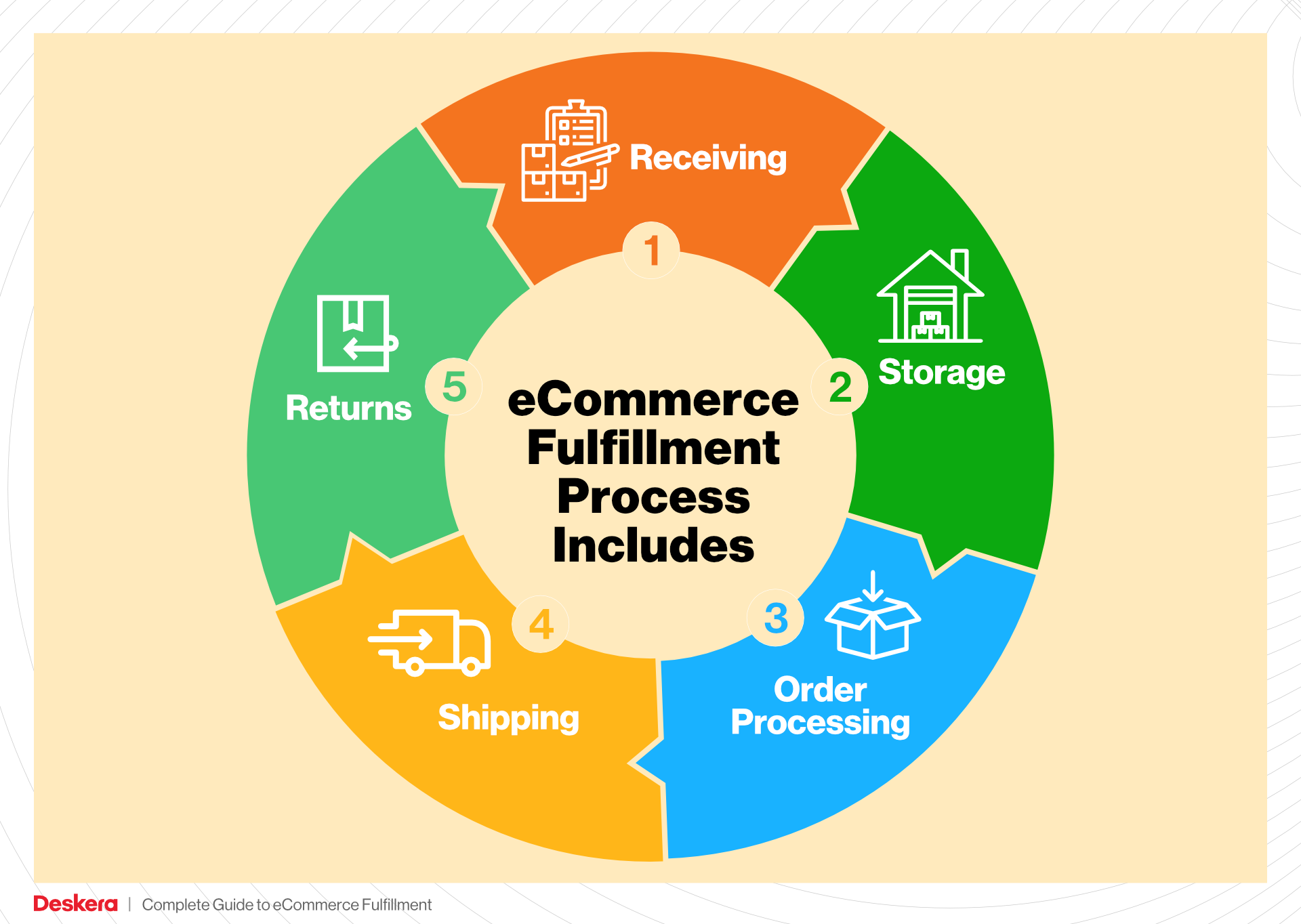
What You’ll Learn In This Guide
- What is E-commerce Fulfillment? An Introduction for Growing Businesses
- The Order Fulfillment Process: From ‘Buy’ Button to Customer’s Door
- Comparing Fulfillment Models: In-House vs. 3PL vs. Dropshipping
- A Deep Dive into Amazon FBA: Pros, Cons, and Who It’s For
- Core Services Offered by Fulfillment Centers
- How to Choose a Fulfillment Partner: A 6-Point Checklist
- Understanding Fulfillment Pricing: A Breakdown of Common Fees
- Frequently Asked Questions (FAQs) about Fulfillment
- Conclusion: Is Outsourcing Fulfillment the Right Move for Your Business?
- Important Disclaimer
The Order Fulfillment Process: From ‘Buy’ Button to Customer’s Door
1. Receiving Inventory
The first step in the order fulfillment process is receiving inventory, which involves the careful intake of goods into your warehouse or fulfillment center. Upon arrival, products must be counted and inspected to ensure that the correct quantities and quality standards are met. This is crucial for maintaining an accurate inventory and preventing stock discrepancies that could lead to order fulfillment errors.
During this phase, each item is assigned a Stock Keeping Unit (SKU) or barcode, which facilitates tracking and retrieval throughout the order fulfillment process. Efficient receiving practices not only help in identifying any discrepancies but also lay the groundwork for effective inventory management. A well-organized receiving process ensures that products are quickly processed and made available for storage or immediate order fulfillment, which is vital for maintaining customer satisfaction and operational efficiency.
2. Warehouse Storage
Once the inventory has been received and verified, the next step is warehouse storage. This involves organizing the products within the fulfillment center in a manner that maximizes space and accessibility. Effective storage solutions are essential for streamlining the picking process later on.
Items can be stored in various configurations—on shelves, in bins, or on pallets—depending on the nature of the products and the layout of the warehouse. The goal is to store items in a way that minimizes retrieval time when orders come in. Implementing inventory management systems that utilize advanced technologies like RFID or barcoding can significantly enhance the accuracy and speed of storage, ensuring that products are easily locatable and reducing the risk of stockouts or overstock situations.
3. Order Picking
The order picking step is where the actual fulfillment of customer orders begins. Once an order is placed, an order management system generates a pick list, which outlines the specific items and quantities needed for that order. Efficient picking is critical because it directly impacts the speed of order fulfillment and, subsequently, customer satisfaction.
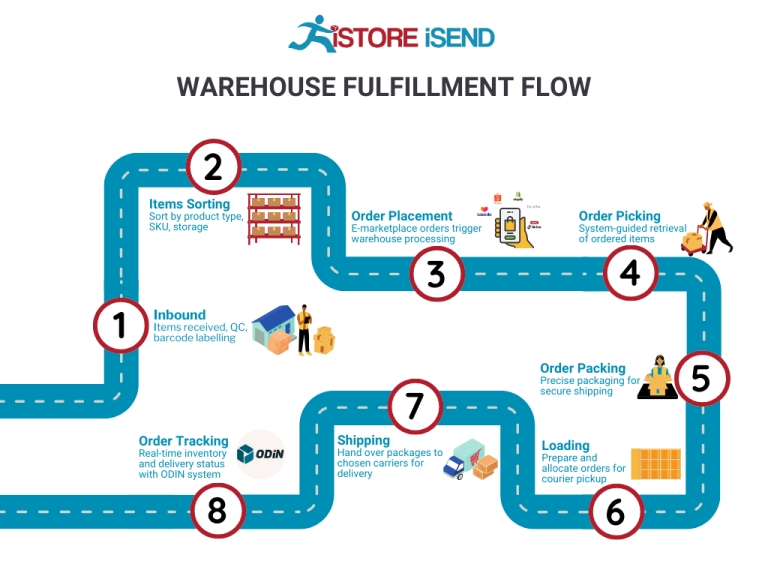
Depending on the size of the operation, picking can be done manually or with the assistance of automated systems. For instance, in smaller operations, employees may manually retrieve items from shelves, while larger warehouses may employ automated picking robots. The accuracy of this process is paramount; mistakes in picking can lead to incorrect orders, returns, and dissatisfied customers. Therefore, implementing quality control measures, such as double-checking picked items against the pick list, can help mitigate errors and enhance the overall efficiency of the fulfillment process.
4. Order Packing
After items have been picked, they must be carefully packed for shipping. This step involves selecting appropriate packing materials and ensuring that products are securely contained to prevent damage during transit. Optimizing the packing process is essential not only for protecting the products but also for minimizing shipping costs.
Using dimensional weight (DIM weight) calculations, businesses can determine the most cost-effective way to pack items, ensuring that the package dimensions are as small as possible while still providing adequate protection. Additionally, including return shipping materials and labels in the package can enhance the customer experience by making returns more straightforward. A well-executed packing process contributes significantly to operational efficiency and can help reduce the likelihood of returns due to damaged goods.
5. Shipping & Delivery
The final step in the order fulfillment process is shipping and delivery, which involves transferring the packed orders to a shipping carrier for delivery to the customer. This phase can include multiple carriers, especially for last-mile delivery, where companies like FedEx or UPS may hand off packages to local postal services for final delivery.
Shipping logistics can be complex, requiring careful coordination between various carriers to ensure timely delivery. Businesses must be vigilant about choosing the right shipping methods that align with customer expectations for speed and cost. Moreover, tracking systems should be in place to keep customers informed about their order status, which can enhance customer satisfaction and reduce inquiries related to order status.

In summary, a well-executed shipping process not only fulfills the order but also reinforces the brand’s reputation for reliability and customer service. By understanding and optimizing each step of the order fulfillment process, e-commerce businesses can significantly improve their operational efficiency and customer satisfaction, leading to sustained growth and success.
Comparing Fulfillment Models: In-House vs. 3PL vs. Dropshipping
Fulfillment Model Comparison Table
| Model | Who Handles Inventory | Best For (Business Stage) | Key Advantage | Key Disadvantage |
|---|---|---|---|---|
| In-House Fulfillment | The business itself | Startups, Small to Medium Businesses | Full control over inventory and processes | Higher overhead costs and resource demands |
| Third-Party Logistics (3PL) | External logistics provider | Growing Businesses | Scalability and access to expertise | Less control over operations and inventory |
| Dropshipping | Supplier or manufacturer | Startups, Niche Businesses | Low startup costs and no inventory management | Lower profit margins and reliance on suppliers |
In-House Fulfillment
In-house fulfillment refers to a model where e-commerce businesses manage their own inventory and order processing directly from their own facilities. This approach is ideal for startups and small to medium businesses that want to maintain direct control over their inventory and fulfillment processes. By keeping operations in-house, businesses can tailor their systems to fit their specific needs, allowing for personalized customer service and the ability to quickly respond to changes in demand. Additionally, in-house fulfillment can foster a stronger connection with the brand, as the business can oversee every aspect of the order process, from picking and packing to shipping. However, this model often involves higher overhead costs related to staffing, warehousing, and technology. As a business scales, these costs can become burdensome, particularly if demand fluctuates significantly.
Third-Party Logistics (3PL)
Third-party logistics (3PL) providers offer a comprehensive solution for businesses looking to outsource their order fulfillment operations. In this model, a business partners with an external logistics provider that manages inventory, warehousing, and shipping on behalf of the company. This is particularly advantageous for growing businesses that need to scale quickly without the capital investment required for in-house fulfillment operations. 3PL providers come equipped with specialized expertise and advanced technology, which can enhance efficiency and provide access to a broader shipping network. This model also allows businesses to focus on core competencies such as marketing and product development rather than the complexities of logistics. However, the trade-off is a loss of direct control over inventory and fulfillment processes, which can lead to potential discrepancies in service levels and customer experience if the 3PL partner does not meet expectations.
Dropshipping
Dropshipping is a fulfillment model where e-commerce retailers do not hold any inventory themselves. Instead, when a customer places an order, the retailer purchases the item from a third-party supplier who then ships it directly to the customer. This model is particularly appealing for startups and niche businesses that want to minimize upfront investment and avoid the complexities of inventory management. Dropshipping eliminates the need for warehousing and inventory costs, allowing entrepreneurs to focus on marketing and customer service. However, this model comes with its challenges, notably lower profit margins and a heavy reliance on suppliers for product availability and shipping. As the retailer has no control over stock levels or fulfillment timelines, customer satisfaction can suffer if the supplier fails to meet delivery expectations. Additionally, the competition in dropshipping is fierce, making it crucial for businesses to differentiate themselves through branding and customer service.
Conclusion
Choosing the right fulfillment model is essential for the scalability and efficiency of your e-commerce business. In-house fulfillment offers control and customization but can strain resources as the business grows. Third-party logistics provide scalability and expertise, but at the cost of some operational control. Dropshipping allows for low-risk entry into the e-commerce space, but it requires careful management of supplier relationships to ensure customer satisfaction. Each model has its advantages and disadvantages, and the best choice will depend on your business’s specific needs, resources, and growth stage. Understanding these differences will enable e-commerce business owners to make informed decisions that align with their operational goals and customer expectations.
A Deep Dive into Amazon FBA: Pros, Cons, and Who It’s For
Understanding Fulfillment by Amazon (FBA)
Fulfillment by Amazon (FBA) is a logistics service offered by Amazon that allows sellers to store their products in Amazon’s fulfillment centers. Amazon then takes care of storage, packaging, and shipping products directly to customers. This service has become increasingly popular among e-commerce businesses looking to scale their operations, as it leverages Amazon’s extensive logistics network and customer trust.
How FBA Works
-
Product Listing: Sellers create a product listing on Amazon and specify that they will use FBA. They need to comply with Amazon’s guidelines for product eligibility.
-
Inventory Shipment: Sellers prepare their products and ship them to Amazon’s fulfillment centers. Amazon provides specific shipping guidelines to ensure products arrive in good condition.
-
Storage: Once received, products are stored in Amazon’s warehouse until sold. The seller is charged for storage space based on the volume of inventory stored.
-
Order Processing: When a customer places an order, Amazon handles the entire fulfillment process. This includes picking the item from the warehouse, packing it, and shipping it to the customer.
-
Customer Service: Amazon also manages customer service and returns for FBA orders, allowing sellers to focus on growing their business rather than handling logistics.
-
Payment and Fees: After the sale, Amazon deducts its fees from the sale price and transfers the remaining balance to the seller.
Pros of Using Amazon FBA
-
Prime Eligibility: One of the most significant advantages of FBA is that products become eligible for Amazon Prime. This can significantly increase sales, as Prime members often prefer items that can be shipped quickly and free of charge.
-
Customer Trust: Amazon has a robust reputation for reliability and customer service. By using FBA, sellers benefit from this trust, which can lead to higher conversion rates and customer loyalty.
-
Multi-Channel Fulfillment: FBA is not limited to Amazon sales. Sellers can utilize FBA for orders from their own website or other sales channels, streamlining their logistics under one umbrella.
-
Scalability: FBA allows sellers to scale their businesses without the need for extensive investment in warehousing and logistics infrastructure. As sales grow, sellers can easily send more inventory to Amazon.
-
Simplified Returns Management: Amazon handles all aspects of returns for FBA products, reducing the burden on sellers and ensuring a smooth experience for customers.
Cons of Using Amazon FBA
-
High Fees: While FBA can simplify operations, it comes with significant costs. These include fulfillment fees (based on size and weight), storage fees (charged monthly), and additional fees for long-term storage. Sellers must carefully calculate these costs to ensure profitability.
-
Strict Inventory Rules: Amazon has stringent inventory management rules. Sellers need to adhere to guidelines on product labeling, packaging, and shipping. Failure to comply can lead to penalties or even suspension of selling privileges.
-
Commingling Risks: FBA uses a commingling process, where inventory from different sellers is stored together. This can pose risks, such as receiving returns that do not belong to the seller or issues with counterfeit products. Sellers must be cautious and may consider using the “Stickered Inventory” option to mitigate this risk.
-
Limited Control: By outsourcing fulfillment to Amazon, sellers may find they have less control over the customer experience. Factors such as shipping speed, packaging, and handling are in Amazon’s hands.
-
Inventory Management Challenges: Sellers must continuously monitor their inventory levels to avoid stockouts or excessive storage fees. Balancing supply and demand can be challenging, especially for seasonal products.
Who is FBA Best For?
Fulfillment by Amazon is particularly well-suited for:
-
Small to Medium-Sized Businesses: These sellers may not have the resources to manage their own logistics and can benefit from Amazon’s infrastructure.
-
E-commerce Startups: Startups looking to enter the market quickly can leverage FBA to handle logistics while focusing on product development and marketing.
-
Brands Seeking Visibility: Businesses aiming to increase their visibility on Amazon can benefit from the Prime badge and the trust associated with Amazon fulfillment.
-
Sellers with High Sales Volume: Businesses that already have a high sales volume can maximize the efficiency of FBA, as the fees may be offset by increased sales and reduced overhead.
-
Multi-Channel Sellers: Brands that sell on multiple platforms can streamline their logistics by using FBA for all orders, simplifying inventory management.
In conclusion, Fulfillment by Amazon offers an attractive solution for many e-commerce businesses, providing significant advantages in terms of logistics efficiency and customer trust. However, potential sellers must weigh the costs and challenges associated with FBA to determine if it aligns with their business strategy and growth objectives.
Core Services Offered by Fulfillment Centers
Inventory Management & Warehousing
Inventory management is the backbone of any fulfillment operation. Fulfillment centers provide robust inventory management systems that track stock levels, orders, sales, and deliveries in real-time. These systems often integrate with e-commerce platforms to synchronize data, ensuring that businesses have accurate visibility of their inventory at all times.
The benefits of effective inventory management extend beyond just knowing what products are available. By maintaining optimal stock levels, fulfillment centers help e-commerce businesses avoid costly stockouts or overstock situations. This balance minimizes carrying costs and maximizes sales opportunities. Additionally, advanced inventory management can facilitate just-in-time (JIT) practices, allowing businesses to respond rapidly to market demand without the burden of excessive inventory.
Moreover, proper warehousing practices ensure that products are stored efficiently and securely. Fulfillment centers typically utilize modern storage techniques, such as automated storage and retrieval systems (AS/RS), to maximize space and streamline operations. This efficiency translates into faster order processing times, ultimately enhancing customer satisfaction.
Pick and Pack Services
Pick and pack services are integral to the order fulfillment process. Once an order is received, fulfillment centers employ skilled teams or automated systems to “pick” the ordered items from the warehouse. These items are then “packed” securely for shipping. The process involves selecting the right items based on specific packing slip instructions, which detail the SKU, quantity, and sometimes the location within the warehouse.
The primary advantage of pick and pack services is the efficiency they introduce into the order fulfillment cycle. By automating or streamlining these tasks, fulfillment centers reduce the likelihood of human error, ensuring that customers receive the correct items in a timely manner. This accuracy is critical for maintaining customer trust and satisfaction, which can significantly impact repeat purchases and brand loyalty.
Furthermore, fulfillment centers often optimize the packing process to minimize shipping costs. By calculating the dimensional weight and selecting appropriate packaging materials, they ensure that shipments are cost-effective while also protecting the products during transit. This not only saves money but also contributes to a more sustainable shipping process by reducing waste.
Kitting and Assembly
Kitting and assembly services are particularly beneficial for e-commerce businesses that offer bundled products or require pre-assembly of items before shipping. This service involves grouping multiple items together into a single package or preparing products for sale that require assembly. For instance, a fulfillment center might combine a toy with its accessories or assemble furniture pieces before shipping.
The primary benefit of kitting and assembly services is the ability to offer customers value-added products that enhance their shopping experience. Bundled offers can increase average order values and encourage customers to purchase more items at once. Additionally, having products pre-assembled before shipping can significantly reduce the time it takes for customers to start using their purchases, improving overall satisfaction.
From an operational standpoint, kitting and assembly streamline inventory management. Instead of tracking individual items, businesses can manage bundled products as single SKUs, simplifying the inventory process. This efficiency can lead to improved order accuracy and faster processing times, which are vital for scaling operations.
Returns Management (Reverse Logistics)
Returns management, also known as reverse logistics, is a critical service offered by fulfillment centers that addresses the complexities of handling product returns. This process begins with the inclusion of return shipping materials and labels in customer orders, making it easy for customers to send back unwanted items. Once the return is initiated, the fulfillment center manages the inspection, sorting, and processing of returned items.
The benefits of effective returns management are multifaceted. Firstly, it enhances customer satisfaction by providing a seamless and hassle-free return experience. In today’s e-commerce landscape, customers expect easy returns, and businesses that fail to deliver can lose sales and damage their reputation.
Moreover, a well-organized returns process can recover value from returned products. Fulfillment centers can assess returned items for restocking, refurbishment, or recycling, ensuring that businesses minimize losses associated with returns. They can also provide valuable insights into return trends, helping businesses identify potential product issues or areas for improvement in their offerings.
In conclusion, the core services provided by fulfillment centers—inventory management, pick and pack services, kitting and assembly, and returns management—are essential for e-commerce businesses looking to scale efficiently. By leveraging these services, businesses can enhance operational efficiency, improve customer satisfaction, and ultimately drive revenue growth.
How to Choose a Fulfillment Partner: A 6-Point Checklist
1. Location & Warehouse Network
Importance:
The geographical location of your fulfillment partner’s warehouses can significantly impact shipping times and costs. A partner with strategically located warehouses can help you reach your customers more efficiently, which is crucial for maintaining customer satisfaction and reducing shipping expenses.
Questions to Ask:
– Where are your warehouses located, and how does this align with my primary customer base?
– Can you offer multiple fulfillment centers to ensure faster delivery times?
– How do you manage your logistics for last-mile delivery in remote areas?
2. Technology & Integrations
Importance:
Modern order fulfillment relies heavily on technology to ensure accuracy and efficiency. A partner that utilizes advanced technology for inventory management, order processing, and shipping will enhance your operational efficiency and provide real-time tracking for both you and your customers.
Questions to Ask:
– What order management system do you use, and can it integrate with my existing e-commerce platform?
– Do you provide real-time inventory tracking and reporting features?
– How do you handle system outages or technical issues, and what is your backup plan?
3. Specializations (e.g., cold storage, oversized items)
Importance:
Different products require different handling and storage conditions. If your business deals with specialized items, such as perishable goods or oversized products, it’s vital to partner with a fulfillment center that has the necessary capabilities and expertise.
Questions to Ask:
– Do you have specialized facilities for cold storage or handling fragile items?
– What procedures do you have in place for managing inventory that requires special conditions?
– Can you accommodate seasonal fluctuations in product type or volume?
4. Scalability & Capacity
Importance:
As your business grows, your fulfillment needs will evolve. A good fulfillment partner should have the capacity to scale operations in line with your growth, whether that means handling increased order volumes, expanding product lines, or accommodating seasonal spikes in demand.
Questions to Ask:
– How do you manage increased order volume during peak seasons?
– What is your current capacity, and how quickly can you scale up operations if needed?
– Can you provide examples of how you’ve helped other clients scale their fulfillment processes?
5. Pricing and Contracts
Importance:
Understanding the pricing structure and contract terms is essential for maintaining profitability. A transparent pricing model helps you budget effectively and avoid unexpected costs. It’s also crucial to ensure that contract terms are flexible enough to accommodate your changing needs.
Questions to Ask:
– What is your pricing structure, and what factors can influence costs (e.g., shipping zones, dimensional weight)?
– Are there any hidden fees (e.g., for storage, packing materials, or returns)?
– What is the duration of the contract, and what are the terms for termination or renegotiation?
6. Customer Support & Reviews
Importance:
Reliable customer support can make or break your fulfillment experience. A partner that is responsive and helpful can help resolve issues quickly, minimizing disruptions to your operations. Additionally, reviews from other businesses can provide insights into the partner’s reliability and service quality.
Questions to Ask:
– What level of customer support do you offer, and how can I reach your support team?
– Can you provide references or case studies from current or past clients?
– How do you handle complaints or issues related to order fulfillment?
Conclusion
Choosing the right fulfillment partner is a critical decision for scaling your e-commerce business. By using this checklist, you can ensure that you evaluate potential partners thoroughly, aligning their capabilities with your specific needs and growth objectives. Taking the time to ask the right questions will help you find a partner that not only supports your current operations but also positions you for future success.
Understanding Fulfillment Pricing: A Breakdown of Common Fees
Initial Setup Fees
Initial setup fees are a one-time charge incurred when you first partner with a fulfillment center. These fees can vary significantly based on the complexity of your needs and the fulfillment provider’s offerings. Typically, the setup process includes:
- Account Setup: This involves creating your account in their system, which may include integrating your e-commerce platform.
- Custom Packaging Design: If you require branded packaging or specific packing materials, there may be additional costs associated with designing and producing these items.
- Inventory Setup: This can include the costs of receiving and cataloging your initial inventory, which may require additional resources and time.
To calculate initial setup fees, providers often base their charges on the time and resources needed to get your account operational. It’s essential to get a detailed breakdown of what these fees cover to avoid unexpected costs.
Receiving Fees
Receiving fees are charged every time inventory arrives at the fulfillment center. These fees typically cover the labor and equipment costs involved in unloading, inspecting, and recording the inventory.
The calculation of receiving fees can depend on several factors:
- Volume of Goods: Many providers charge a flat fee per pallet or per shipment, while others may charge based on the total weight or number of items.
- Complexity of the Receiving Process: If your goods require special handling, such as temperature control or fragile item considerations, expect to pay more.
It’s crucial to understand the receiving fee structure, as frequent shipments can accumulate significant costs.
Storage Fees (per pallet/bin)
Storage fees are recurring charges for the space your inventory occupies in the fulfillment center. These fees are typically assessed monthly and can vary based on:
- Type of Storage: Different rates may apply for bulk storage (pallets) versus smaller items (bins).
- Duration of Storage: Some providers charge based on the number of pallets or bins stored, while others may have tiered pricing based on the length of time items are stored.
- Seasonal Variations: During peak seasons, such as holidays, storage fees may increase due to higher demand for space.
To keep storage fees manageable, regularly assess your inventory turnover rates and consider implementing just-in-time inventory practices.
Pick & Pack Fees (per item/order)
Pick and pack fees are charged for the labor involved in selecting items from storage and packing them for shipment. This fee is typically calculated based on the number of items in each order or the total number of orders processed.
Factors influencing pick and pack fees include:
- Order Complexity: Orders with multiple items or special packing requirements (like gift wrapping) may incur higher fees.
- Automation: Providers using automated systems may offer lower pick and pack fees compared to those relying on manual labor.
Understanding your average order size and complexity can help you estimate these fees more accurately and explore ways to streamline your order fulfillment process.
Shipping Fees
Shipping fees encompass the costs associated with transporting the packed orders to the customer. These fees can vary widely based on:
- Carrier Selection: Different carriers offer varying rates based on service levels (e.g., standard, expedited) and shipping distances.
- Package Dimensions and Weight: Shipping costs are often calculated based on the greater of the actual weight or dimensional weight (DIM weight), which considers the package size.
- Destination: Shipping to remote areas may incur additional surcharges.
To minimize shipping fees, consider negotiating rates with carriers or exploring fulfillment centers that have established partnerships with shipping providers for better rates.
Conclusion: Tips for Getting an Accurate Quote
When seeking quotes from fulfillment centers, clarity is key. Here are some practical tips:
- Provide Detailed Information: Share specifics about your inventory types, order volume, and any special handling needs.
- Ask for Itemized Quotes: Request detailed breakdowns of fees associated with each aspect of the fulfillment process to understand potential costs better.
- Consider Long-Term Needs: Discuss how fees may change as your business scales and inquire about volume discounts or long-term contracts.
- Evaluate Additional Services: Assess any extra services that may be beneficial, such as returns processing or custom packaging, and their associated costs.
By understanding the common fulfillment pricing models and asking the right questions, you can ensure that your business is well-prepared to manage fulfillment costs effectively as you scale.
Frequently Asked Questions (FAQs) about Fulfillment
1. What is order fulfillment?
Order fulfillment refers to the entire process of receiving, processing, and delivering customer orders. It encompasses inventory management, order processing, picking and packing items, shipping them to customers, and handling returns. Essentially, it is how a business ensures that customers receive the products they have purchased.
2. Why is order fulfillment important for my business?
Efficient order fulfillment is crucial for maintaining customer satisfaction and loyalty. It directly impacts your brand reputation, sales, and profitability. A well-managed fulfillment process ensures that orders are delivered accurately and on time, minimizing errors and enhancing the overall customer experience.
3. What are the main steps in the order fulfillment process?
The order fulfillment process typically involves several key steps:
1. Receiving Inventory: Accepting and inspecting incoming goods.
2. Inventory Storage: Organizing products in a warehouse or fulfillment center.
3. Order Processing: Managing the receipt of customer orders and preparing them for shipment.
4. Picking: Selecting items from inventory based on order details.
5. Packing: Preparing items for shipment in a way that minimizes damage.
6. Shipping: Sending the packaged order to the customer.
7. Returns Processing: Handling returned items and managing restocking or refunds.
4. What’s the difference between a warehouse and a fulfillment center?
While both warehouses and fulfillment centers store products, they serve different purposes. A warehouse is primarily focused on storage and inventory management, often holding goods for long periods. In contrast, a fulfillment center specializes in processing customer orders quickly and efficiently, facilitating the picking, packing, and shipping processes to ensure fast delivery.
5. What is a 3PL (Third-Party Logistics)?
A 3PL provider is a company that offers outsourced logistics services, including order fulfillment, inventory management, and transportation. Partnering with a 3PL can help businesses scale their operations by leveraging the provider’s expertise, technology, and infrastructure, allowing them to focus on core business activities without the burden of managing logistics in-house.
6. How much do fulfillment services cost?
The cost of fulfillment services can vary significantly based on factors such as order volume, storage needs, and service level agreements. Common pricing structures include per-order fees, storage fees based on cubic space, and additional charges for picking, packing, and shipping. It’s essential to evaluate your specific needs and compare quotes from multiple providers to find the most cost-effective solution.
7. How can I improve my order fulfillment efficiency?
To enhance order fulfillment efficiency, consider the following strategies:
– Invest in technology: Utilize order management systems (OMS) and inventory management software to streamline processes.
– Optimize warehouse layout: Organize your fulfillment center for easy access to frequently picked items.
– Implement automation: Use automated picking systems and packing robots to reduce labor costs and improve accuracy.
– Regularly review processes: Continuously analyze and refine your fulfillment processes to identify bottlenecks and areas for improvement.
8. What challenges can arise in order fulfillment?
Common challenges in order fulfillment include:
– Inventory management issues: Running out of stock can lead to customer dissatisfaction, while overstocking increases carrying costs.
– Logistics delays: Slow or damaged deliveries can harm your brand reputation.
– Returns processing: Managing returns efficiently is crucial for customer satisfaction and inventory control.
– Demand fluctuations: Sudden changes in demand can lead to either excess inventory or stockouts.
9. How do I handle returns in the fulfillment process?
Effective returns processing involves including return shipping materials with orders, clearly communicating your return policy, and promptly inspecting returned items. Develop a system for restocking items that are in good condition, and establish procedures for dealing with damaged or unsellable products. A smooth returns process can enhance customer trust and encourage repeat business.
10. What role does technology play in order fulfillment?
Technology is essential for modern order fulfillment. It enables businesses to automate tasks, track inventory in real-time, manage orders efficiently, and analyze data for better decision-making. Implementing an integrated system that combines inventory management, order processing, and shipping can significantly improve accuracy and speed throughout the fulfillment process.
Conclusion: Is Outsourcing Fulfillment the Right Move for Your Business?
Evaluating the Benefits of Outsourcing Fulfillment
Outsourcing fulfillment can be a transformative decision for e-commerce businesses looking to scale. One of the most significant benefits is time savings. By partnering with a fulfillment service, you can delegate the complex logistics of order processing, inventory management, and shipping, allowing you to focus on core business activities such as marketing and customer engagement. This shift can lead to faster response times and improved customer satisfaction, both critical components in today’s competitive landscape.
Scalability is another crucial advantage of outsourcing fulfillment. As your business grows, so does the complexity of your operations. A dedicated fulfillment partner can provide the infrastructure and expertise necessary to handle increased order volumes without compromising service quality. This adaptability is essential for navigating seasonal peaks or unexpected surges in demand, ensuring that you can meet customer expectations consistently.
Moreover, partnering with a fulfillment service gives you access to industry expertise that can enhance your operational efficiency. These providers often employ advanced technology and best practices that streamline processes, optimize shipping routes, and reduce costs. Leveraging this expertise can help you stay ahead of the competition and foster long-term growth.
However, the choice of a fulfillment partner is paramount. Not all providers are created equal, and selecting the right one can significantly impact your business’s success. It’s essential to consider factors such as reliability, shipping speed, and the ability to integrate with your existing systems.
Take Action
As a strategic next step, conduct an audit of your current shipping and fulfillment processes. Evaluate your pain points, analyze your growth potential, and determine if an outsourcing solution aligns with your business goals. By making informed decisions now, you can set the stage for sustainable growth and enhance your customer experience in the future.
Important Disclaimer
⚠️ Important Disclaimer
The information in this guide is for educational purposes. Fulfillment services, pricing, and platform features change frequently. Always conduct your own due diligence and consult with providers directly before making business decisions.
